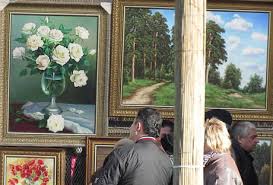Buddhist philosophy
LENINGRAD SCHOOL OF PAINTING (part 4)
 However, in 1928, after a series of publications in the journal Revolution and Culture, edited by N. I. Bukharin, supported by the section of literature and art of the Communist Academy, a new aggravation of the ideological struggle in art began. Realistic traditions and easel art were opposed by new types of creativity (photography, design, cinema), and models of Western modernism were offered as a standard. This had consequences for Vkhutein (as the Academy of Arts was called in 1923). The directors were accused of restoring academism. The dissatisfaction of some teachers and students of the institute was supported by the art groups “Proletariat”, “Circle”, a group of P. N. Filonov, who opposed, among other things, any control in the development of culture in general and the art school in particular. Continue reading
However, in 1928, after a series of publications in the journal Revolution and Culture, edited by N. I. Bukharin, supported by the section of literature and art of the Communist Academy, a new aggravation of the ideological struggle in art began. Realistic traditions and easel art were opposed by new types of creativity (photography, design, cinema), and models of Western modernism were offered as a standard. This had consequences for Vkhutein (as the Academy of Arts was called in 1923). The directors were accused of restoring academism. The dissatisfaction of some teachers and students of the institute was supported by the art groups “Proletariat”, “Circle”, a group of P. N. Filonov, who opposed, among other things, any control in the development of culture in general and the art school in particular. Continue reading
HISTORY OF LANDSCAPE GENRE DEVELOPMENT (part 1)
 Translated from French, the word “landscape” (paysage) means “nature”. This is what the genre is called in fine art, the main task of which is the reproduction of natural or human-modified nature.
Translated from French, the word “landscape” (paysage) means “nature”. This is what the genre is called in fine art, the main task of which is the reproduction of natural or human-modified nature.
In addition, the landscape is a specific work of art in painting or graphics, showing the viewer nature. The “hero” of such a work is a natural motif or a natural motif invented by the author.
Elements of the landscape can be found already in cave art. In the Neolithic era, primitive masters schematically depicted rivers or lakes, trees and stone blocks on the walls of caves. On the Tassilin-Ager plateau in the Sahara, drawings were found with scenes of hunting and driving herds. Continue reading
ABOUT AQUARIAN PAINTING TECHNIQUE (part 3)
 The foregoing applies to any kind of art, but it is watercolor that is particularly susceptible to temperament and the “movement of the brush” emanating from the movement of the spirit of the master. It denotes a creative, mental and philosophical attitude to the material. This is the main secret and the problem of ownership of equipment. A high concentration of energy, self-control, a clear thought, a clear task, and a subtle sense of water, colors, and paper are the qualities of a painter that are necessary for the embodiment of an image in a whimsical watercolor painting.
The foregoing applies to any kind of art, but it is watercolor that is particularly susceptible to temperament and the “movement of the brush” emanating from the movement of the spirit of the master. It denotes a creative, mental and philosophical attitude to the material. This is the main secret and the problem of ownership of equipment. A high concentration of energy, self-control, a clear thought, a clear task, and a subtle sense of water, colors, and paper are the qualities of a painter that are necessary for the embodiment of an image in a whimsical watercolor painting.
A good illustration of what has been said is a brief acquaintance with one of the traditional pictorial techniques of the East. In China and Japan, there are ancient traditions of writing with water-based materials, mostly ink painting. The traditions of the East are very different from European ones. Continue reading



